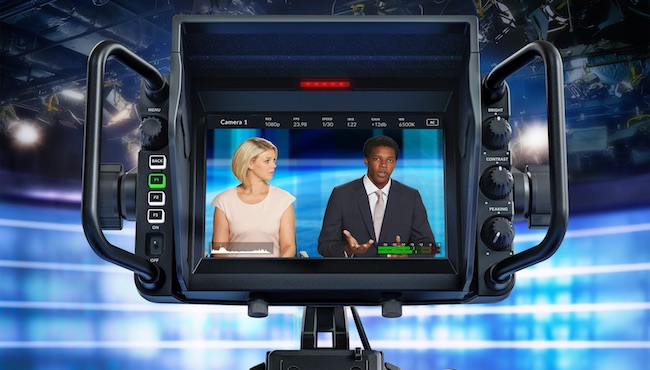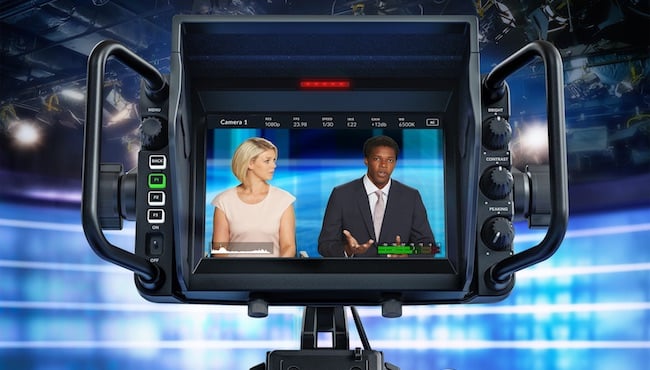
 The $1795 URSA Studio Viewfinder
The $1795 URSA Studio Viewfinder
RedShark Review: The URSA Studio Viewfinder can turn your Blackmagic Ursa or Ursa Mini camera into a studio or remote production unit with just three screws. Ned Soltz reckons Ursa users who shoot in studio or fixed remote scenarios shouldn’t be without it.
Those of us who have shot studio or fixed position remote cameras know not only the importance of external monitoring but also of such features as sunshades and complete integration with the camera.
The URSA Studio Viewfinder achieves all of these goals.
It’s a rather large unit with its 7” IPS LCD screen, side handles, removable sunshade and mounting bracket. In fact the total unit weights 5.9lbs (2.7kg) and measures 11.9x13 inches (30.4x33.1 cm).
It comes with a mounting bracket that attaches to the top handle of the Ursa or Ursa Mini (handle not included with either the Studio Viewfinder or Camera). Three screws attach the bracket to the top handle and the viewfinder slides into a v-mount plate. Of course, the angle is adjustable via knobs on the viewfinder side.
It has the identical connectors as the optional Blackmagic eyepiece viewfinder—SDI and power connectors that connect to the front ports on the camera. Of course, you can’t connect the Studio Viewfinder and the eyepiece Viewfinder simultaneously.
A toggle switch on the left side of the viewfinder powers the unit on or off. Also on this left side are a top wheel to access and select camera menu options as well as three programmable function buttons. This replicates the functionality of the eyepiece viewfinder. On the right side are knobs to adjust viewfinder brightness, contrast and peaking.
The viewfinder itself displays relevant camera settings including resolution, fps, lens, iris, shutter speed, camera gain, white balance, battery power and camera number for multi cam shots. A large tally light faces talent and the viewfinder includes three number placards to identify multiple cameras.
But the most impressive feature of the Studio Viewfinder is its support for 1280 and 1920 resolutions up to 60p as well as Rec 601, Rec 709 and Rec 2020 color space. Additionally it can support both 4:2:2 YUV and 4:4:4 RGB color sampling.
Set up took me sixty seconds. And it only took that long because I dropped a screw and had to fight the cat for it.
I had the opportunity to put the Viewfinder through its paces on a Blackmagic Ursa Mini 4.6K EF mount camera but the performance would be no different on any Ursa or Ursa Mini model.
It powers up immediately with the camera and allows both Viewfinder and built-in camera LCD to be live simultaneously.
Performance of the Viewfinder was nothing short of stellar. The IPS LCD panel was bright and with the use of the sunshade viewing in outdoor sunny conditions certainly was acceptable.
Changing camera settings using the Menu dial was quick and precise. There was no lag and the large dial allowed easy adjustments.
The articulating mount was easy to adjust via knobs which, by the way, have adjustable tension.
While this test set up did not include the Blackmagic ATEM Talkback Converter 4K, it should be noted that this device will allow communication with the switcher as well as talkback to the camera operators. As the director punches up the shot on the switcher, the Talkback Converter can activate the tally on the appropriate camera.
As always, Blackmagic manages to deliver high quality professional equipment at reasonable price points. The entire ecosystem of camera, viewfinder, Talkback converter and various switcher models enables a full studio or remote production unit to be configured at prices far below that of its competitors.
We’ve already had the opportunity to review the Ursa cameras and find that they produce pleasing images (I am definitely a fan of BMD skin tones) which are easy to grade and with RAW, ProRes and DNxHD options.
Something that we cannot evaluate is long term durability of the product line. With two week loaner units, assessing how a product will hold up to serious professional use is not possible.
Yet I can conclude that Blackmagic has produced yet another serviceable and versatile product with the Studio Viewfinder. It does what a studio viewfinder should do and does so at a most reasonable price of $1795.
Ursa users who shoot in studio or fixed remote scenarios shouldn’t be without it.
Tags: Production


Comments